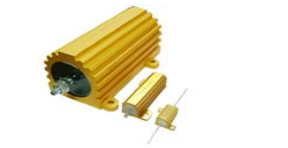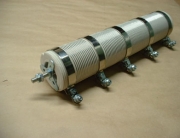Our range of wire wound resistors have been used in thousands of applications for over 50 years in Australia. An inner west Sydney electrician has used our metal clad resistors in an interesting application recently. The application involved using a 0.01 ohm, 50 watt power resistor in a current sensing application on an industrial sized electric motor driven roller door. The door was driven by a 1.5 kilowatt a.c. electric motor. The application for the power resistor was to detect the current drawn by the motor and detect current overload conditions that could be  experienced when the roller door stalled, or potentially if the door was to close on a vehicle entering the facility. The increase in motor current would then be sensed in the resistor and a significantly higher voltage would develop across that resistor, which, in turn, would signal to the motor control electronics that a ‘fault condition’ had occurred and open the relay that controls the a.c. door motor. This is a necessary safety feature of all electric door openers and this type of current sense circuitry via a power resistor is often used in the electronic design of the controllers.
experienced when the roller door stalled, or potentially if the door was to close on a vehicle entering the facility. The increase in motor current would then be sensed in the resistor and a significantly higher voltage would develop across that resistor, which, in turn, would signal to the motor control electronics that a ‘fault condition’ had occurred and open the relay that controls the a.c. door motor. This is a necessary safety feature of all electric door openers and this type of current sense circuitry via a power resistor is often used in the electronic design of the controllers.
The GMR series of metal clad wire wound resistors are ideal for these application as their small physical size in comparison to, for example, tubular wire wound power resistors, is significantly smaller. A comparison of 50 watt power resistors of each type highlights these differences:
Physical Dimensions: GMR Metal Clad Resistors Versus Tubular Power Resistors:
50 watt GMR Metal Clad Resistor – 52 mm length
50 watt EP type tubular wire wound resistor – 114 mm length
This example demonstrates the significant difference in length of the 2 resistor types.
Contact us for further details and advice on power resistor selection.

